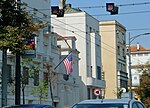Royal Compound, Belgrade
1920s establishments in SerbiaBuildings and structures in BelgradeInstances of Lang-sr using second unnamed parameterKingdom of YugoslaviaPalaces in Serbia ... and 2 more
Royal residences in SerbiaSavski Venac

The Royal Compound (Serbian: Краљевски комплекс, romanized: Kraljevski kompleks) is a complex of residences built with the personal funds of King Alexander I for the Karađorđević royal family between 1924 and 1937. The compound is located in the Dedinje neighborhood, a prestigious area of Belgrade, Serbia. It consists of two primary residences: the Royal Palace and the White Palace. The Royal Compound covers an area of 134 hectares, of which 27 hectares surround the Royal Palace and another 12 hectares the White Palace. The service buildings include kitchens, garages, guards barracks and the office of the Marshal.
Excerpt from the Wikipedia article Royal Compound, Belgrade (License: CC BY-SA 3.0, Authors, Images).Royal Compound, Belgrade
Пивљанина Баја, Belgrade Београд (Савски венац) (Savski Venac Urban Municipality)
Geographical coordinates (GPS) Address Nearby Places Show on map
Geographical coordinates (GPS)
| Latitude | Longitude |
|---|---|
| N 44.765555555556 ° | E 20.453611111111 ° |
Address
Бели двор
Пивљанина Баја
11000 Belgrade, Београд (Савски венац) (Savski Venac Urban Municipality)
Central Serbia, Serbia
Open on Google Maps







